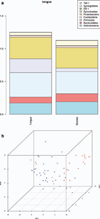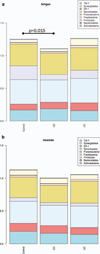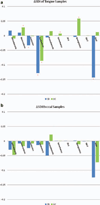Alterations in diversity of the oral microbiome in pediatric inflammatory bowel disease
- PMID: 21987382
- PMCID: PMC4208308
- DOI: 10.1002/ibd.21874
Alterations in diversity of the oral microbiome in pediatric inflammatory bowel disease
Abstract
Background: Oral pathology is a commonly reported extraintestinal manifestation of Crohn's disease (CD). The host-microbe interaction has been implicated in the pathogenesis of inflammatory bowel disease (IBD) in genetically susceptible hosts, yet limited information exists about oral microbes in IBD. We hypothesize that the microbiology of the oral cavity may differ in patients with IBD. Our laboratory has developed a 16S rRNA-based technique known as the Human Oral Microbe Identification Microarray (HOMIM) to study the oral microbiome of children and young adults with IBD.
Methods: Tongue and buccal mucosal brushings from healthy controls, CD, and ulcerative colitis (UC) patients were analyzed using HOMIM. Shannon Diversity Index (SDI) and Principal Component Analysis (PCA) were employed to compare population and phylum-level changes among our study groups.
Results: In all, 114 unique subjects from the Children's Hospital Boston were enrolled. Tongue samples from patients with CD showed a significant decrease in overall microbial diversity as compared with the same location in healthy controls (P = 0.015) with significant changes seen in Fusobacteria (P < 0.0002) and Firmicutes (P = 0.022). Tongue samples from patients with UC did not show a significant change in overall microbial diversity as compared with healthy controls (P = 0.418).
Conclusions: As detected by HOMIM, we found a significant decrease in overall diversity in the oral microbiome of pediatric CD. Considering the proposed microbe-host interaction in IBD, the ease of visualization and direct oral mucosal sampling of the oral cavity, further study of the oral microbiome in IBD is of potential diagnostic and prognostic value.
Copyright © 2011 Crohn's & Colitis Foundation of America, Inc.
Figures



Similar articles
-
Alterations in the gut microbiome of children with severe ulcerative colitis.Inflamm Bowel Dis. 2012 Oct;18(10):1799-808. doi: 10.1002/ibd.22860. Epub 2011 Dec 14. Inflamm Bowel Dis. 2012. PMID: 22170749 Free PMC article.
-
Analysis of endoscopic brush samples identified mucosa-associated dysbiosis in inflammatory bowel disease.J Gastroenterol. 2018 Jan;53(1):95-106. doi: 10.1007/s00535-017-1384-4. Epub 2017 Aug 29. J Gastroenterol. 2018. PMID: 28852861
-
A microbial signature for Crohn's disease.Gut. 2017 May;66(5):813-822. doi: 10.1136/gutjnl-2016-313235. Epub 2017 Feb 7. Gut. 2017. PMID: 28179361 Free PMC article.
-
Differentiating ulcerative colitis from Crohn disease in children and young adults: report of a working group of the North American Society for Pediatric Gastroenterology, Hepatology, and Nutrition and the Crohn's and Colitis Foundation of America.J Pediatr Gastroenterol Nutr. 2007 May;44(5):653-74. doi: 10.1097/MPG.0b013e31805563f3. J Pediatr Gastroenterol Nutr. 2007. PMID: 17460505
-
Gut microbiome diversity in acute infective and chronic inflammatory gastrointestinal diseases in North India.J Gastroenterol. 2016 Jul;51(7):660-71. doi: 10.1007/s00535-016-1193-1. Epub 2016 Mar 19. J Gastroenterol. 2016. PMID: 26994772 Review.
Cited by
-
The Association between Periodontitis and Inflammatory Bowel Disease: A Systematic Review and Meta-analysis.Biomed Res Int. 2021 Mar 12;2021:6692420. doi: 10.1155/2021/6692420. eCollection 2021. Biomed Res Int. 2021. PMID: 33778080 Free PMC article.
-
Alterations of oral microbiota in Chinese children with viral encephalitis and/or viral meningitis.J Microbiol. 2022 Apr;60(4):429-437. doi: 10.1007/s12275-022-1560-y. Epub 2022 Feb 14. J Microbiol. 2022. PMID: 35157224 Free PMC article.
-
Frequency of Tongue Cleaning Impacts the Human Tongue Microbiome Composition and Enterosalivary Circulation of Nitrate.Front Cell Infect Microbiol. 2019 Mar 1;9:39. doi: 10.3389/fcimb.2019.00039. eCollection 2019. Front Cell Infect Microbiol. 2019. PMID: 30881924 Free PMC article.
-
Oral microbiome: possible harbinger for children's health.Int J Oral Sci. 2020 Apr 30;12(1):12. doi: 10.1038/s41368-020-0082-x. Int J Oral Sci. 2020. PMID: 32350240 Free PMC article. Review.
-
The oral microbiome: Role of key organisms and complex networks in oral health and disease.Periodontol 2000. 2021 Oct;87(1):107-131. doi: 10.1111/prd.12393. Periodontol 2000. 2021. PMID: 34463991 Free PMC article. Review.
References
-
- Sartor RB. Microbial influences in inflammatory bowel diseases. Gastroenterology. 2008;134:577–594. - PubMed
-
- Rowland M, Fleming P, Bourke B. Looking in the mouth for Crohn’s disease. Inflamm Bowel Dis. 2010;16:332–337. - PubMed
-
- Dupuy A, Cosnes J, Revuz J, et al. Oral Crohn disease: clinical characteristics and long-term follow-up of 9 cases. Arch Dermatol. 1999;135:439–142. - PubMed
-
- Katz J, Shenkman A, Stavropoulos F, et al. Oral signs and symptoms in relation to disease activity and site of involvement in patients with inflammatory bowel disease. Oral Dis. 2003;9:34–40. - PubMed
Publication types
MeSH terms
Substances
Grants and funding
LinkOut - more resources
Full Text Sources
Medical
Research Materials
